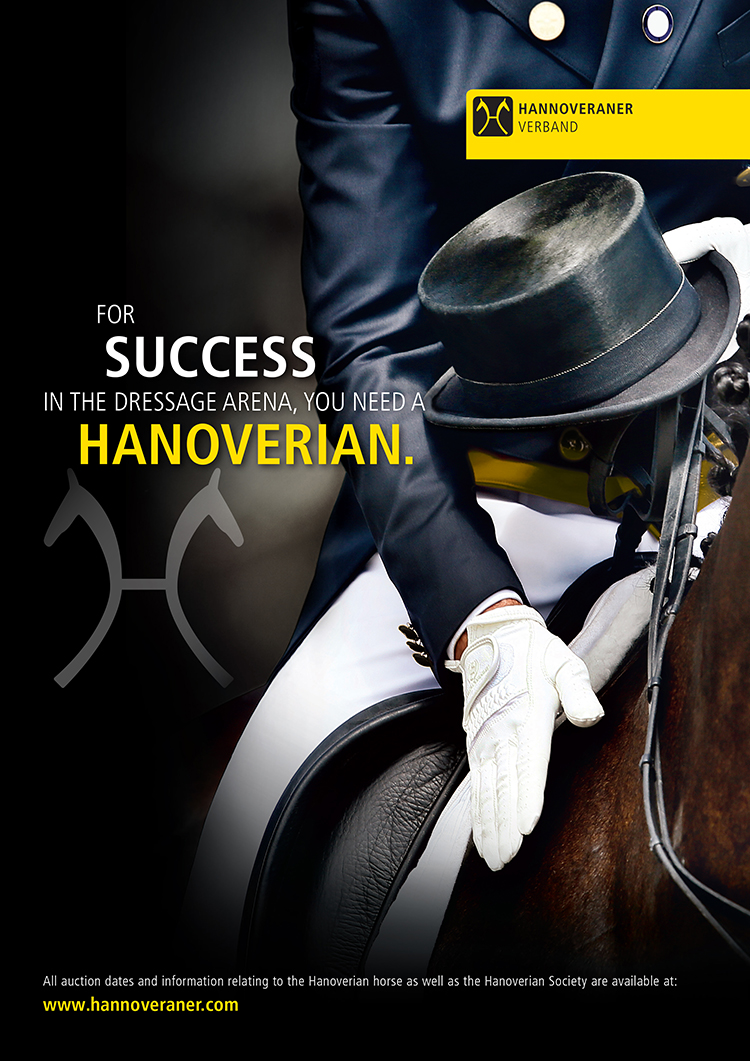Christopher Hector interviews Leonie Bramall
Canadian born Leonie Bramall now calls Germany and Gestüt Mühlenort home. As a young rider in western, eventing and dressage, Leonie was already something of a star in Canada, but she set her sights higher, and at the age of 18 Leonie headed for the home of dressage, Germany and the Canadian National trainer at the time, Johann Hinnemann.
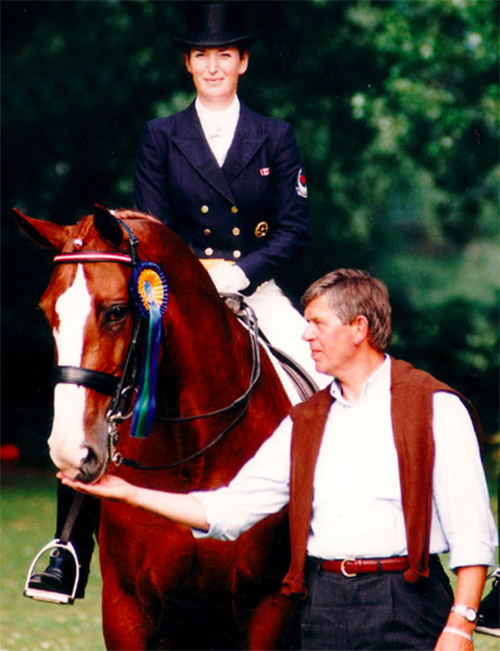
Leonie and Jo and Gilbona, the Oldenburg mare that carried Leonie into the Canadian Team for the Barcelona and Atlanta Games and the WEG in Den Haag.
Leonie spent 15 years with Jo, helping train both horses and riders, and was involved with horses such as Beltain (famed now as the sire of Belissimo) and helped him to gain stallion approval on the basis of his sport successes.
Leonie competed a number of horses successfully at Grand Prix level, but was also successful with young horses, like Fosbury who won the German Five Year old championship at Verden in 1992.
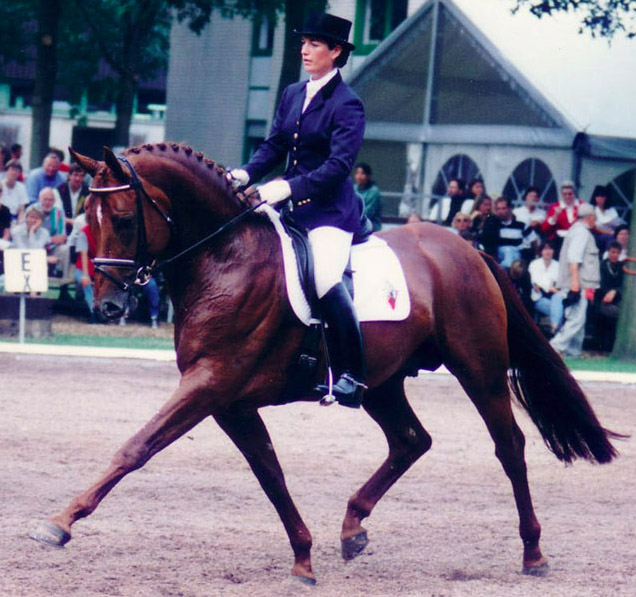
With Relevant at the 1996 Bundeschampionate
Through Johann Hinnemann, Leonie spent two years training the stallions of one of the most important breeding operations in Germany, Stud Vorwerk. Leonie schooled both Relevant and Rohdiamant, qualifying Rohdiamant for the Nürnberger Burg Pokal.
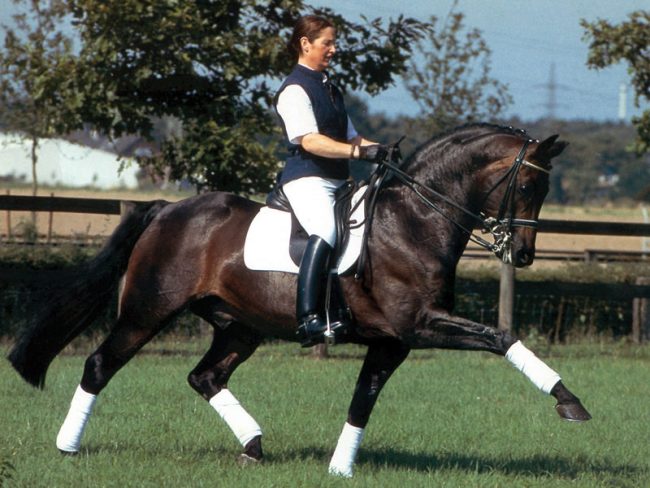
Training Rohdiamant
These days Leonie is more involved in running the training / breeding / sales centre she shares with her partner, Volker Dusche. She is also in high demand and takes clinics all over the world.
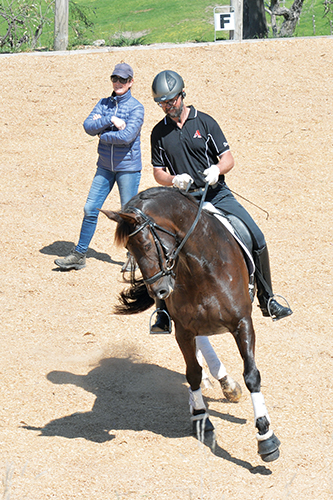
Leonie is an interesting mix. On one hand she is the most intensely ‘in there’ teacher, running a minute by minute commentary throughout her lessons, but on another level, she is a sophisticated dressage thinker, and it is always great to sit down and ready when you throw her a couple of questions, like this one:
One of the real problems in dressage at any level is getting contact, while at the same time getting the horse’s neck out THERE, control without making the frame short…
“The problem is we are always trying to do something visually correct – what we are told needs to be done – and horses always have different biomechanical ways of moving. Some horses have absolutely no problem being behind the vertical and still moving through their bodies, relaxed and using their back. Some horses are really hard to get round, their necks are open. It is always the whole concept of the body, it is never about the neck.”
“It’s hard to teach riders not to fiddle with the frame. As humans we are very front-end orientated, our comfort zone is what is happening in front of us, while what is happening behind us is 70% of our riding, and only 30% is what is happening in front. Our check of reality tends to be what happens in the front end, is the horse soft in the mouth? It can be backed off the bit and soft in the mouth, and riders are happy because they have a light contact – that doesn’t mean it is working from behind. This is always a challenge, when is the horse working positively in a biomechanical way through its body, even if it is for a moment behind the vertical – that is not necessarily a bad thing, on the vertical can become a bit over-rated.”
Even looking at dressage at the top – the European Championships at Aachen for example – many of those horses were too short in front, too constricted, it does seem to be a problem…
“The thing is, if you put more pressure on behind, you are going to get more pressure on the front, it is always a fine line where the balance point comes. In creating an outline, a frame that the judges are going to be happy with, and at the same time not compromising so that there’s too much pressure in front, and not enough from behind, it is all relative. The way a horse is constructed plays a definite role. Some horses can piaffe and have the worst type of body, you think why would anyone try to turn that into a dressage horse? But biomechanically, it can piaffe – even though the silhouette is not the classical one. It is an ongoing struggle, we are all trying to find the compromise and make it work.”
There was a recent video that went round cyberspace showing some of the top modern horses doing handstand in piaffe, and then there was a clip of Liselot Linsenhoff and Piaffe – 50 years ago – piaffing, and that was so much nicer, lowered in the hindquarters, just a touch in front of the vertical, everything looked sweetly harmonious…
“What is happening is always in the eye of the beholder. There is no right and wrong, it is always about trying to find a balance and get as correct as we can.”
You’ve talked about the problem of getting students to release the outside rein…
“Not necessarily the outside rein, I’m not telling people to ride without an outside rein, what I was saying is release the pressure, not give away the outside rein. Take the pressure and soften, pressure, contact, soften. Often I am trying to get the horse to stay connected on the back end, but the next stage is when it is well connected on the back end, the challenge is to stay connected but allow the horse to use its neck a little more openly. If the horse is good behind, then when you softened the neck, you didn’t get a tipping on the forehand problem, you enhance through the forehand, which was what we are always after.”
“It is really about the half halts, the horse should go bing bing under behind, and yet the whole front end shouldn’t change – THAT’S what a half halt is.”
“I think a lot of times people are into technically having a reaction, but they don’t really understand what a half halt is. It is a challenge to really work through that, and not just end up with something that you might say, it’s better than most other people, but it is not the epitome of what we are trying to achieve.”
What’s a half halt?
“It’s a connecting, a re-cycling, of energy, which is carried on into the new forward movement. It is a constant re-cycling of energy.”
So how do I do it?
“Sending energy forward, catching it again. It is hard to explain, you have to feel it. When you are teaching you have to try and take riders to where they feel that moment. For example, when the horse is in trot, almost take it to walk and then trot it on again, without changing the neck, and making the back end do it. It’s going whoa in front, and go behind, at the same time. That’s what a piaffe is, balance the horse with the half halts, the neck stays where it is, and you keep re-charging in the back end, and the horse keeps stepping off the ground.”
It was interesting, in your clinics you use shoulder in trot, to shoulder in walk, the only other trainer I’ve seen do that is Miguel Tavora, it’s a great exercise…
“I do it all the time, it’s one of my favorite things. The rider is schooling for the longitudinal and the lateral connection at the same time, it’s very valuable. It teaches the horse to balance. With a rider who hasn’t done it before, when you ask for the transition to walk, they fall left and right, they get lateral dislodgement. They are not equal enough, they don’t have that moment of bringing the horse back and staying forward, connected into the withers, so they deviate laterally. You have to make riders aware, again, outside leg is very important in shoulder in. Someone said to me, why has no-one ever told me to use my outside leg in the shoulder in? I’ve always been told to push the quarters out to ride shoulder in. I said I don’t think that’s the right concept, try this, and she’s like oh my goodness, and she gets a really good shoulder in.”
The penny drops, another student enlightened, now on to the next lesson…
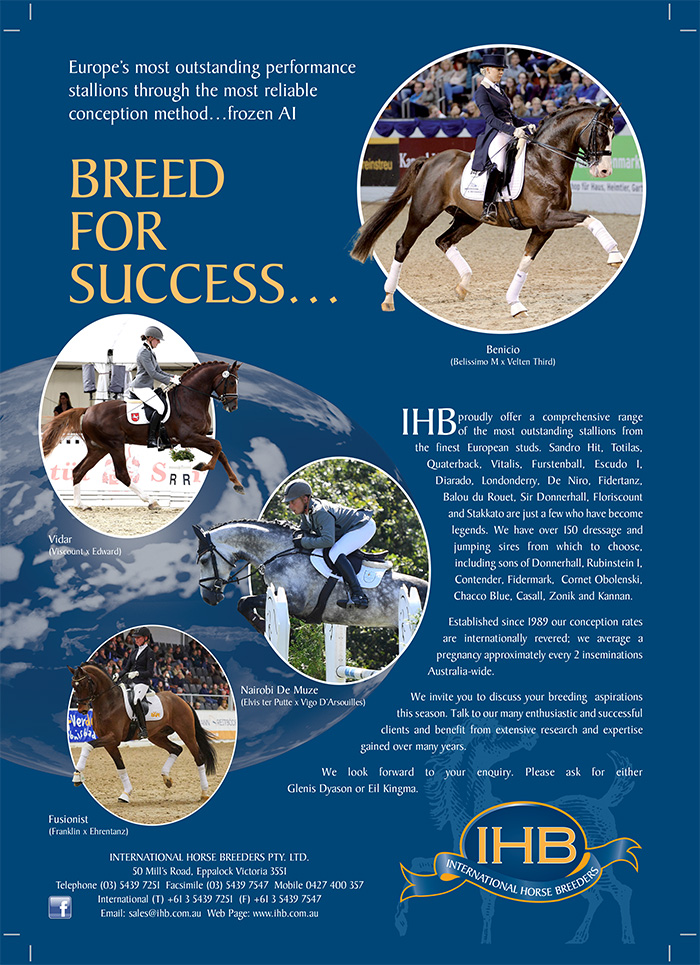
http://www.horsemagazine.com/thm/2016/02/talking-dressage-with-leonie-bramall/



